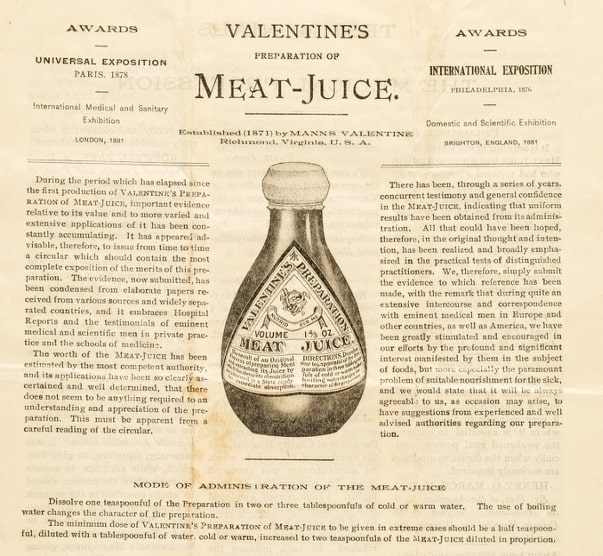Dissecting the Christmas Dinner!
We all love a bit of Christmas dinner but in true RCPI Heritage Centre spirit, I have decided to dissect some of the main dinner components and tell you how these were once (or possible still!) used in the treatment of illnesses and injuries of days gone by!
Potatoes
In 19th-century Jewish folk medicine, potatoes were pressed to warts so that the ailment could be absorbed. This is similar to a Dublin practice, whereby warts are rubbed with raw potato before being buried in clay. The treatment can then be repeated the next day using the rest of the potato.
Tocosh is the ancient Incan medicine made from fermented potato pulp. Containing penicillin, it is traditionally used to heal various infections, gastritis, pneumonia, altitude sickness and strengthening women after childbirth. The Incas believed it was a gift from the sun god, Inti, for the preservation of the body. Tocosh is still made in the Peruvian Sierra region.
Anne MacFarlane and Tomas de Brún (2010) explain that in Ireland, sliced raw potatoes were laid over burns to heal and soothe the skin. It was claimed that a sore throat could be soothed by filling a sock full of hot potatoes and put it around the neck as a collar. It was said a whitlow (painful infection of the finger caused by the herpes virus) could be cured by pouring water that potatoes had been boiled in over the infection.
Rosemary
William Thomas Fernie wrote in 1895 of the medicinal uses for rosemary, spanning not only then, but in ancient treatment. He mentions how rosemary was thought by the “ancients” to refresh the memory and bring comfort to the mind.
Another rosemary-inspired cure consisted of a distilled mixture of fresh rosemary tops and wine spirits. Its name, Hungary Water is allegedly derived from the Queen Elizabeth of Hungary who in the 14th century was said to have used it to relieve her headaches. This infused water was used through until the 18th century to relieve not only headaches but also toothaches and ringing ears. It could be used as both an oral dosage and as a topical application, according to Elaine Leong (2008).
Pliny the Elder (23-79 AD) claimed rosemary “acts also as a detergent upon freckles”.
Sage
Sage was like rosemary in its alleged cleansing properties against the Plague. Grace Carteret, 1st Countess Granville (c.1667-1744) handwrote a manuscript of recipes from her time, ranging from jams, preserves and simple first-aid. Most interestingly, she gives her own personal recipe for what she calls “Plague Watter [Water]”. The countess lists no less than 36 different herbs and their appropriate measurements, to be mixed with fortified wine and fermented.
In his publication, Fernie talks of how sage’s bitterness and pungency enable the stomach to digest “rich, luscious meats and gravies, if it be eaten therewith”. Does this ring a bell? He then goes on to say these falls within the custom of stuffing poultry with the conventional sage and onion.
.jpg?ver=5dP4v9tpf6H3Bv41TMcoUQ%3d%3d)
Pictured above: Manuscript recipe book of Grace Carteret, 1st Countess Granville (1654-1744)
Brandy
Brandy pudding, brandy butter, and brandy cream are the quintessential components of a good Christmas dessert. But historically, brandy has been used as much more than an after-dinner delight. It was reported on numerous occasions the benefit of brandy and salt in treating inflammation and local injuries (Fenton, 1842). One recipe consisted of one quart of French brandy (British would simply not do) mixed with five ounces of salt. It was corked, shaken, and left for the salt to settle. The dosage ranged, from one tablespoon of brandy and salt with hot water an hour before breakfast, to saturating linen and applying it directly to the body.
Word of warning from Fenton though,
“To insure success it is absolutely necessary… the patient should abstain from all stimulating and exciting drinks”.
It claimed to help with dizziness in the head, determination of blood to the head (also treated with leeches on the temples), and scalds, chilblains, cancers, worms, asthma, itching and even insanity! The list truly goes on.
Henry Guly (2011) wrote about the medicinal uses of brandy in the latter 19th and early 20th centuries. It was primarily used as a cardiac stimulant but also a sedative due to its depressive qualities. At a London hospital, feeding cups administered brandy in anaesthetic procedures. Paradoxically, brandy was also used as a stimulant in the cases of fainting patients.
Meat juice
In the 19th century emerged a new form of invalid nourishment known as Valentine’s Preparation of Meat-Juice. Consisting of meat jus and egg whites, the preparation promised to provide essential nutrients to the sick.
Meat Juice was more effective than beef broth - Instead of boiling the beef like that of broth, the meat was cooked on a low temperature before being pressure-cooked. This meant that the nutrients present in the meat were retained, offering more nutritional value. It claimed to bring relief from nausea, caused by illness, seasickness, morning sickness, and excessive drinking. It was prepared by simply mixing one teaspoon of the preparation in two or three tablespoons of cold or warm water.
One surgeon at Auxiliary Hospital No.287 said in the 1880s:
“We can but congratulate you on the great restorative effects of Valentine’s Meat-Juice in the treatment of our wounded and convalescents”.
Another doctor wrote,
“I consider it very valuable in all conditions where it is essential to conserve the weakened vital powers, especially when the digestive processes are seriously impaired”.
A letter from Valentine’s Meat-Juice Company to Dr Henry Edward Richardson in 1928, mentions the concoction still being used in the cases of influenza and pneumonia.

Pictured above: Valentine's preparation of Meat-Juice : established (1871) by Manns Valentine, Richmond, Virginia, U.S.A. / Valentine's Meat-Juice Company.
So as you feast in the next few days, pay some mind to the ingredients you are consuming and what they were used for. Or on the other hand, maybe don't...
Chiará Morgan
Assistant Keeper of Collections